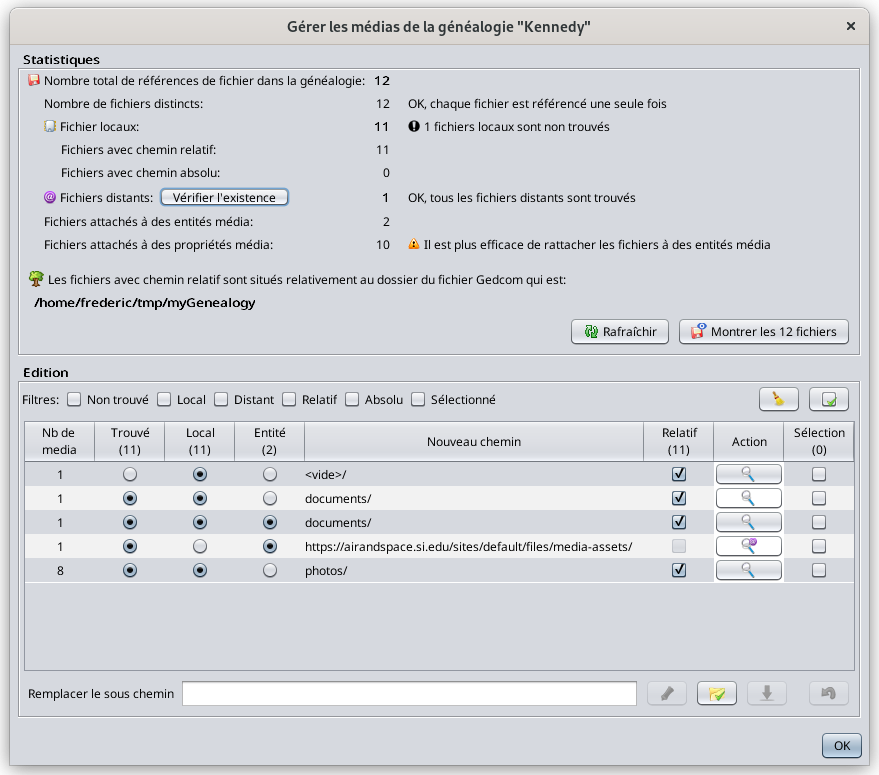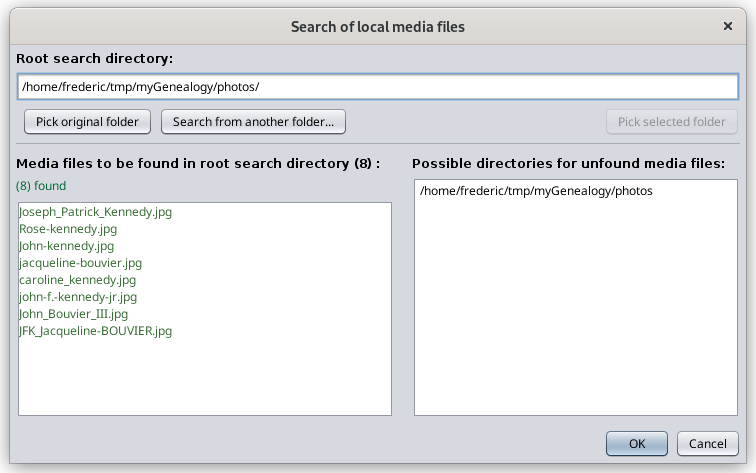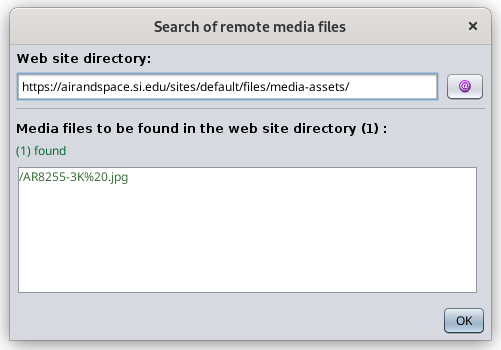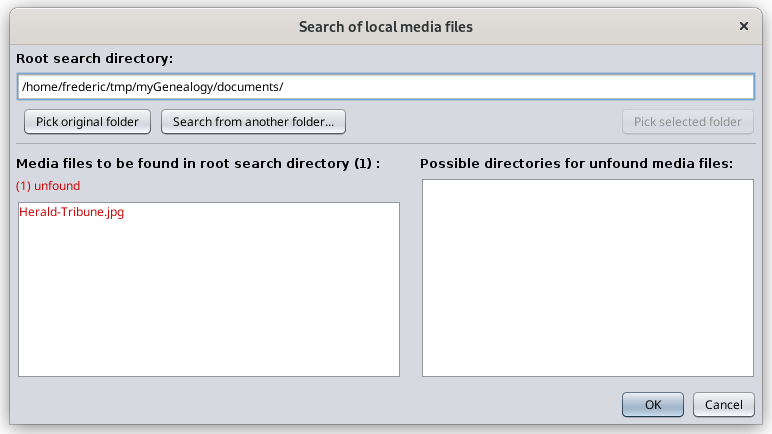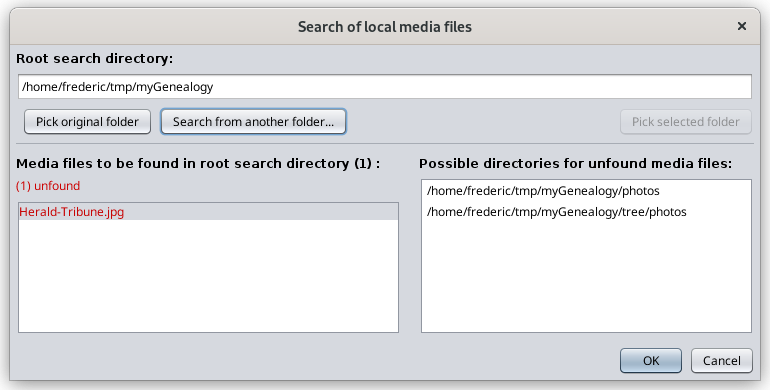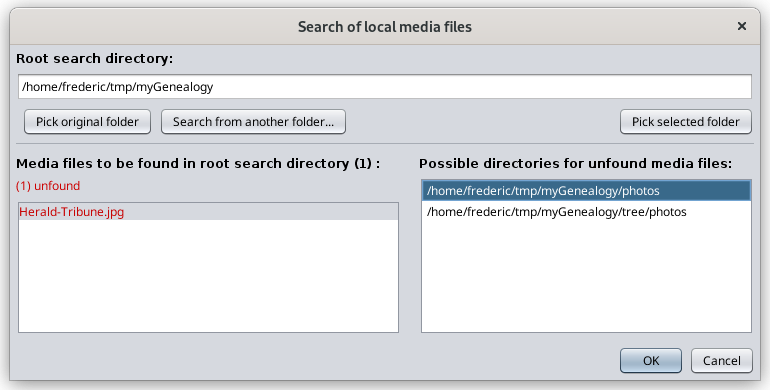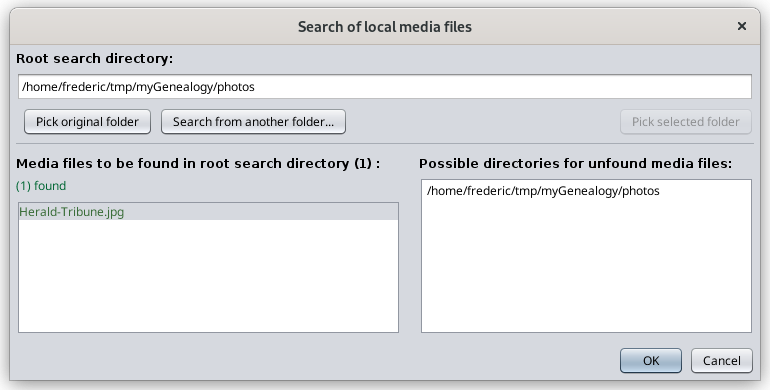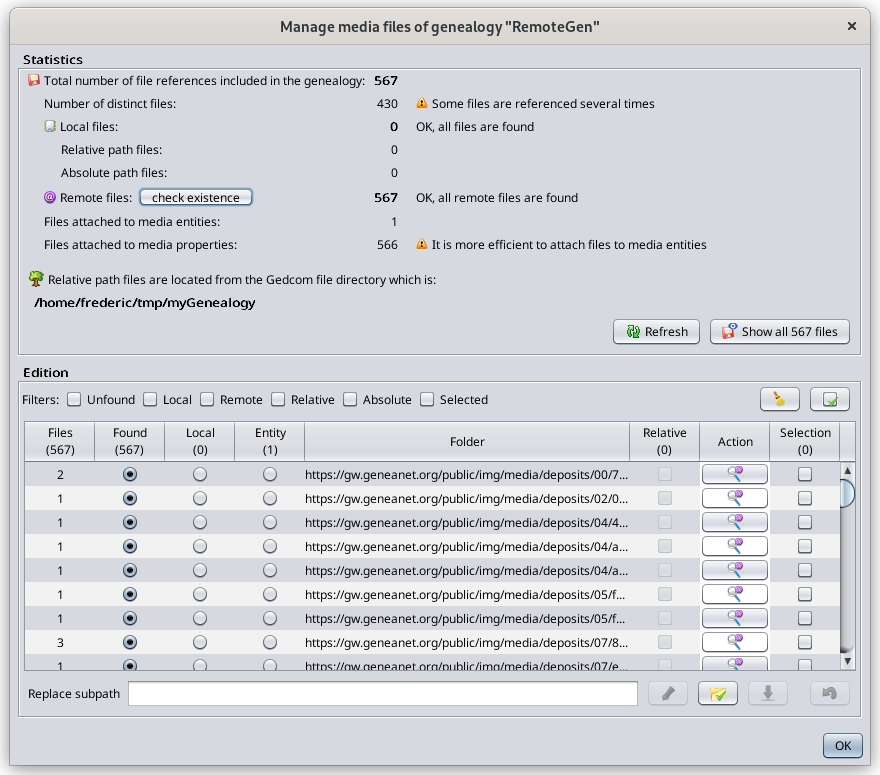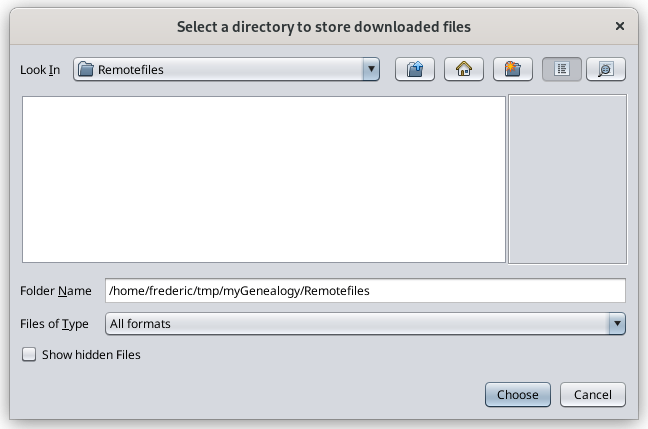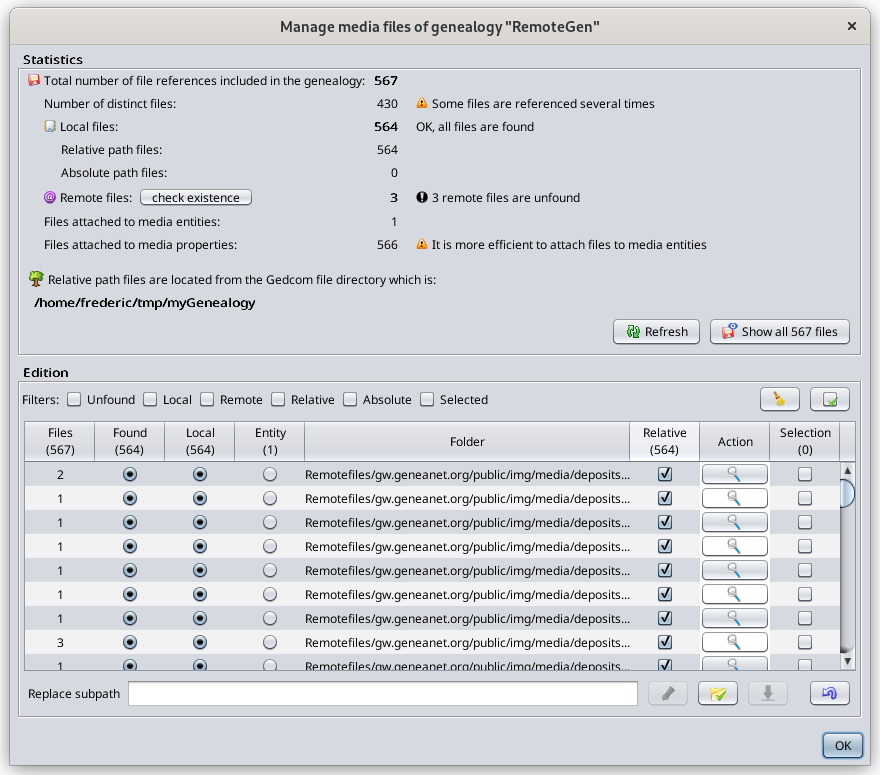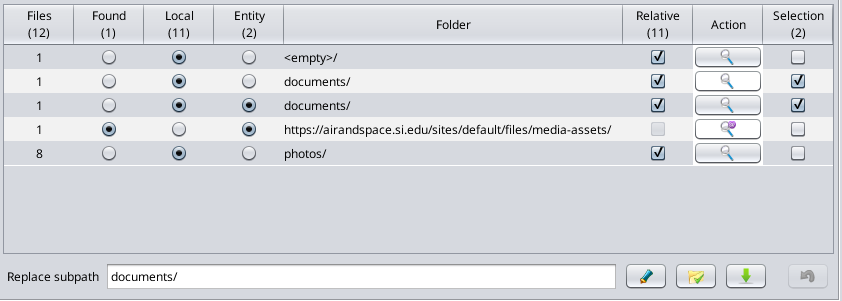Gérer les médias
Le gestionnaire de médias vous permet de vous assurer que tous les fichiers médias utilisés dans votre généalogie existent, que ce soit sur vos disques locaux ou sur Internet, qu'ils sont utilisés et qu'ils sont correctement liés aux événements de vos fichiers Gedcom.
Une situation typique où vous devez utiliser cet outil est si vous avez modifié vos dossiers de photos par exemple, ou si vous venez de migrer votre généalogie à partir d'un autre logiciel.
Description
La fenêtre se compose de deux zones :
- Une zone de statistiques fournissant le nombre de fichiers par catégorie, le nom du répertoire complet de l'emplacement du fichier Gedcom, à partir duquel les fichiers à chemin relatif doivent être pris en compte, et un bouton pour voir tous les fichiers multimédias.
- Une zone d'édition où vous pouvez effectuer 3 types de modifications et les annuler
- Passer d'un chemin relatif à un chemin absolu et vice versa
- Modifier les chemins des dossiers
- Télécharger des fichiers distants depuis Internet vers vos disques locaux et changer le lien en conséquence dans votre fichier Gedcom.
- Passer d'un chemin relatif à un chemin absolu et vice versa
Statistiques
Les indicateurs ont la signification suivante.
- Nombre total de références de fichier est le nombre total de références de fichiers physiques dans votre fichier Gedcom, que ce soit sur vos disques locaux ou sur Internet. Les références de fichiers sont écrites sous forme de propriétés FILE. Les noms de fichiers vides sont inclus dans ce nombre. Ce nombre additionne les fichiers locaux et distants ci-dessous. Il additionne également les fichiers attachés aux entités média et aux propriétés média.
- Le nombre de fichiers distincts est le nombre de fichiers physiques distincts référencés par la généalogie. Il peut être inférieur au nombre ci-dessus. En effet, un même fichier physique peut être indiqué dans plusieurs propriétés FILE.
Un avertissement s'affiche si certains fichiers physiques sont référencés plus d'une fois. C'est inefficace, car si vous changez le nom du fichier sur le disque, vous devrez mettre à jour la généalogie à plusieurs endroits. Cliquez sur le bouton "Afficher tous les fichiers" pour identifier ces fichiers "en double" et les consolider dans la même entité média.
-
Fichiers locaux : il s'agit du nombre de fichiers physiquement situés sur vos disques (disque dur, clés USB, etc.). Il est composé de fichiers à chemin relatif et de fichiers à chemin absolu.
-
Les fichiers avec chemin relatif partent de l'emplacement du fichier Gedcom. Le chemin ne commence pas par "/" ou "C:\" par exemple.
-
Les fichiers avec chemin absolu partent du dossier racine du disque, généralement "/" ou "C:\".
-
-
Fichiers distants : il s'agit du nombre de fichiers physiques situés quelque part sur des sites Internet.
-
Un bouton Vérifier l'existence vous permet de vérifier si tous les fichiers distants existent réellement. Si vous cliquez sur ce bouton, Ancestris analysera tous les fichiers distants et tentera d'y accéder. Cette opération peut prendre beaucoup de temps en fonction de votre connexion Internet et du temps de réponse des différents sites web concernés. S'il n'y a pas de fichiers distants dans votre généalogie, ce bouton sera désactivé.
-
-
Fichiers attachés à des entités média : les références de fichiers (FILE) qui sont des sous-propriétés des entités médias peuvent être utilisées comme références plusieurs fois dans le fichier Gedcom.
-
Fichiers attachés aux propriétés média : les références de fichiers (FILE) qui sont des sous-propriétés des propriétés des médias ne peuvent pas être utilisées ailleurs dans le fichier Gedcom, sauf à réattacher une autre fois le fichier physique.
L'information suivante est le nom du chemin complet de votre fichier Gedcom, à partir duquel les chemins relatifs commenceront.
Enfin, le bouton "Rafraîchir" met à jour les statistiques au cas où certains fichiers auraient été modifiés localement ou à distance, et le bouton "Montrer les fichiers" ouvre la visionneuse de médias avec toutes les images de la généalogie.
Cette visionneuse de médias est la même que celle à laquelle on accède à partir de l'éditeur Cygnus, à une différence près : la liste des images dans Cygnus est limitée aux médias d'événements ou aux médias de sources.
Edition
Cette section comprend plusieurs éléments :
- Une table des dossiers listant tous les dossiers utilisés par la généalogie, divisé en différentes lignes selon que les fichiers inclus dans ces dossiers sont trouvés ou non, locaux ou distants, attachés à des entités ou à des propriétés, avec un chemin relatifs ou absolus.
- Au-dessus de la table se trouvent des filtres qui permettent de n'afficher que certaines lignes.
- À droite des filtres, les boutons Effacer et Sélectionner vous permettant de sélectionner et de désélectionner les lignes plus rapidement. Vous pouvez également sélectionner des lignes à l'aide de la souris.
- Le champ texte et les boutons d'actions situés sous le tableau permettent d'effectuer des modifications globales sur plusieurs lignes à la fois.
Les modifications apportées dans cet éditeur sont effectuées dans le fichier Gedcom et peuvent être annulées soit en utilisant le bouton d'annulation ci-dessous, soit en utilisant les boutons d'annulation/rétablissement de la barre de menu principale d'Ancestris.
Table des dossiers
Chaque ligne du tableau correspond à un groupe de fichiers situés dans un même dossier et avec les mêmes attributs, trouvé/non trouvé, local/distant, entité/propriété et relatif/absolu.
- Les colonnes de gauche sont données pour information.
- Fichiers : nombre de références de fichiers physiques inclus dans le dossier mentionné, qui ont les attributs trouvé, local et entité indiqués.
- Trouvé : coché si les fichiers de ce groupe sont trouvés, sinon ils ne sont pas trouvés.
- Local : cochée si les fichiers de ce groupe sont locaux, sinon ils sont distants.
- Entité : coché si les fichiers de ce groupe sont attachés à des entités, sinon ils sont attachés à des propriétés.
- Dossier : nom du dossier. Il s'agit de la valeur de la propriété FILE du fichier Gedcom. Pour les valeurs FILE vides, Ancestris affichera <vide/> comme indiqué dans la fenêtre principale ci-dessus. Veuillez noter que ces références vides seront considérés comme des fichiers "non trouvés".
- Fichiers : nombre de références de fichiers physiques inclus dans le dossier mentionné, qui ont les attributs trouvé, local et entité indiqués.
- Les colonnes de droite vous permettent de modifier les dossiers et de corriger les fichiers non trouvés.
- Relatif : coché si les fichiers de ce groupe ont un chemin relatif, sinon ils ont un chemin absolu. Un clic sur la case à cocher modifie cet attribut. Il permet de passer d'un chemin relatif à un chemin absolu et vice versa.
- Action : ce bouton ouvre une fenêtre qui liste tous les fichiers inclus dans ce groupe afin de vous aider à les rechercher lorsqu'ils sont introuvables. La fenêtre diffère selon que le groupe est composé de fichiers locaux ou de fichiers distants. Vous trouverez ci-dessous un exemple de chaque fenêtre.
- Sélection : cliquez sur la case à cocher pour sélectionner ou désélectionner la ligne. Les boutons Remplacer et Télécharger s'appliquent à cette sélection.
- Relatif : coché si les fichiers de ce groupe ont un chemin relatif, sinon ils ont un chemin absolu. Un clic sur la case à cocher modifie cet attribut. Il permet de passer d'un chemin relatif à un chemin absolu et vice versa.
Les nombres figurant dans les en-têtes de colonne des attributs indiquent le nombre de fichiers dotés de l'attribut correspondant une fois la liste filtrée.
Le nombre dans l'en-tête de la colonne Sélection indique le nombre de lignes sélectionnées.
Ceci est un exemple de la fenêtre de recherche de fichiers locaux. Une explication de cette fenêtre est fournie dans la section d'utilisation correspondante ci-dessous.
This is an example of the Search window for remote files.
In this "Search of remote media files" window, the Internet button opens up your browser on the corresponding web site directory.
In the list of media files, clicking on a file will try to open it in your browser. The files are listed in green if they could be accessed, in red otherwise.
Filtres
- Unfound: check this filter to only display unfound files.
Please note remote files are initially assumed to be found until an action has revealed there are unfound. Such action is for instance the "Check existence" button in the Statistic section, opening a remote file in your browser from the "Search of remote media files" window, or accessing media files via the Media viewer window, which can be opened via the Show all files" button or the Cygnus editor.
- Local: check this filter to only display local files.
- Remote: check this filter to only display remote files. In particular used when you want to download them.
- Relative: check this filter to only display relative path files.
- Absolute: check this filter to only display absolute path files.
- Selected: check this filter to only display selected files.
Once a filter is applied, the numbers in the column headers adjust themselves to only count the filtered files.
Boutons Effacer et Sélectionner
These actions apply to filtered lines only.
- Clear: click this button to unselect filtered lines.
- Select/Unselect: click this button to swap the selection of mouse-highlighted filtered lines. If no line is mouse-highlighted, swaps the selection box of filtered lines.
Champ et boutons d'actions
- Replace subpath field:
- Applies to selected lines (selection check box).
- When lines are selected, this field displays the longest common path of selected lines.
- It can be edited and the new path string will replace the former one when the Replace button is pressed.
- Applies to selected lines (selection check box).
- Replace button: if the subpath string has been changed, replaces the old subpath with the new one.
- Relative button:
- Applies to all filtered lines, whether selected or not
- Swaps all relative paths to absolute paths and vice versa
- Applies to all filtered lines, whether selected or not
- Download button:
- Applies to selected lines (selection check box).
- Downloads all remote files in a folder of your choice and modified the path to be the corresponding local one.
- The local folder structure will be the one of the Internet web site.
- Undo button:
- Reverse any change made within this editor, up to the situation of the Gedcom file when the Media manager window was last open.
- To undo changes made before that, use the Undo button of the Ancestris main menu bar.
Usage
The main use cases of the Media manager tool are the following.
- To "reconnect" media files to your genealogy if you are migrating from another software or if you have moved files on your computer. This is the problem of 'unfound files" described below.
- To check if all your files are still well connected to your genealogy, in particular remote files.
- To make all files relative rather than absolute
- To download remote files, for instance when importing your genealogy from Geneanet or any genealogy web site, in order to make a local backup copy.
- To simply access and view all your media files
In case you have your main genealogy on a website like Geneanet and Ancestry.com, it is our topmost recommendation to make sure you have usable local copies of this genealogy, including media files, in distinct locations.
A 'usable' copy means a file in Gedcom format with separate media files properly attached to the Gedcom file events and sources.
Problème des 'fichiers non trouvés'
Where can the problem come from?
1. Avez-vous renommer votre dossier médias ou votre fichier média ?
If your photo is in a /mygenealogy/photos/MyPicture.jpg file and your Individual entity references this photo in a FILE tag with value of /mygenealogy/photos/MyPicture.jpg, then the link is valid. Everything is fine.
Now, if you rename your photos directory or just the media file, it may generate a broken link. For instance, if your photo file becomes /mygenealogy/media/MyPicture.jpg with media instead of photos, Ancestris will not find it because it still thinks it is in the "photos" folder, not "medias".
This is enough to break the link. The Media Manager above will consequently display your photo as an unfound media.
2. Avez-vous déplacé votre fichier Gedcom ?
Rather than renaming a media folder or a file, you may have just moved your Gedcom file.
Position relative entre votre fichier Gedcom et votre fichier média
- If your media files are described in relative position with respect to your Gedcom file, the link is lost, because in this case you would have had to move your media files at the same time as your genealogy Gedcom file.
- We recommend that you only specify your media in relative position of your Gedcom file location as this allows you to move your files without renaming the links.
Position absolue entre votre fichier Gedcom et votre fichier média
- If your media files are described in absolute position, the link to the media is not lost because it is not using the position of the Gedcom file.
- But the downside is that if you move your genealogy to a USB key, for example, your media will have remained on your hard drive and you will only be able to see your media if the USB key remains on your computer.
- If it is to show your genealogy to one of your relatives, you will have to move the media to the USB key. But suddenly the links will be broken because the Gedcom file will think that they are still on your computer. You will have to rename them by one in Gedcom or else you use this Media manager tool.
3. Vos fichiers ont-ils été supprimés ?
Another possible reason for a loss of link between your Gedcom file and your media files can also come from file deletions on the disk. It's more annoying because you have first to get hold of these files before continuing with the media manager or else removing the links in the Gedcom file.
The Media manager does not remove the links, it just renames them.
4. Cas des fichiers distants
In the case of remote files, 'unfound files' can just be the result of the web site being reorganised, or renamed or any other web site structural modifications.
Résolution du problème des 'fichiers non trouvés' pour les fichiers locaux
Let us consider the following example with the unfound line below where 1 file is missing in the documents folder.
If you are confident that your media file is somewhere on your computer, click on the "Search" button in the Action column to locate the corresponding media file.
The following "Search of local media files" appears.
This window will help you find the lost file.
In the window above, Ancestris will search for the missing files in all directories underneath the root directory indicated at the top. You can change it using the "Search from another folder..." button, or 'Pick original folder" to go back to the original root directory where the Gedcom file is located.
The files to be found are listed in red in the left column. Otherwise, they will appear in green. In this example, the file to be found is "Herald_Tribune.jpg".
Please note unfound files can also be quickly located using the "Validate Gedcom compliance and Data consistency" tool if you have indicated in the Preference window that files not found are to be considered invalid. However it does not help you find them.
The directories where the files exist are listed in the right-hand-side column.
- If no directory appears on the right, it means the file does not exist in any of the folders underneath the root directory indicated on top. If you change the root folder and still no directory appear, it means the file is either deleted or its name has changed. You would have to use your file explorer on your PC to identify its new name or else recreate the media file.
- If one or more folder is listed on the right, select one of them. The Pick selected folder button should become available. Press it to set the found directory as the new root directory. You can also directly double click on the directory to be selected.
For instance, using the "Search from another folder..." button, I changed the root directory, to myGenealogy and two folders appear on the right-hand-side. It means the missing file - or at least a file with the same name as the missing file - sits within both folders.
If I would rather move the missing file from one of these folders to the one it was supposed to be in before (in this example the documents/ folder), I would use my computer file explorer to do that and reopen the main panel of the Media manager, or press the "Refresh" button to refresh the statistics.
Otherwise, if I want to leave the missing file in that folder, I have to "re-attach" it to the Gedcom file from where it is.
I select the first folder for instance. I get the following window where the "Pick selected folder" becomes enabled.
I press the "Pick selected folder" button and then, the root folder is updated to point to the "photos" folder and the file on the left becomes green again.
I click OK to go back to the Media manager window. The line now appears as found. This is the line with 9 found files in folder "photos/". I was showing 8 found files before. Now it is showing 9, and the line witth the missing file is no longer there.
Done!
Téléchargement des fichiers distants sur Internet
Let's look at a use case where you might want to download remote files.
For instance, you have been working days and nights for two years on your genealogy and have used a web site such as Geneanet, Ancestry.com or Genoom. You have now more than 5000 individuals and 500 media files referenced on Geneanet for instance. This actually happened to a friend of mine.
Of course, you can export your genealogy from Geneanet and open the corresponding Gedcom file from Ancestris. It will work. You will see your genealogy tree with all the pictures as well, even though the pictures are still on the Geneanet web site.
Three issues may arise:
- The first time you display each picture, the response time from Ancestris might be a bit long. This is because the picture is read from the Internet and cached in memory. With many pictures, and depending on the memory size of your computer and the quality of your Internet connection, it might be a bit annoying. Nothing serious though.
- A bit more serious is if you loose your connection temporarily. Ancestris will not see your picture which are only on a remote web site.
- Finally, an issue is much more serious. If the web site disappears - this happened to all Genoom users, you no longer have access to your pictures. You have to make a local copy.
In this situation, you will want to have a copy of your pictures on your computer or a USB drive. But you need all your Gedcom file links to be modified and link to the local files rather than the remote files. Of course!
Here is an example of what you would see and do.
The following window shows the Media manager window right after importing the genealogy called RemoteGen from Geneanet and opening it. It contains 430 files linked 567 times throughout the genealogy.
As we can see, all files are in separate folders on the web site. We are now going to download them all.
By default, all remote files are assumed to be found.
First, we will check that remote files exist on the Internet to only download those that do exist. It would not differ much to just download them all right away, and just get the one that exist.
Ok, so we press the "check existence" button. The progress bar shows the checking process.
Once completed, we can see this on the statistics.
All but 3 files exist.
Select all files using the "Select/Unselect" button next to the filters. If you want, unselect the unfound ones to exclude them.
Then click the Download button. The following window lets you choose the destination folder.
Then click the Choose button. The download process starts.
Upon completion, the following result window appears.
Here, it says that 564 files out of the 567 have been downloaded successfully. The 3 unfound files have been set to unfound in case there were not already.
Press OK and the Media manager window now shows 564 local files in their local folders, with the same folder structure as there is on Geneanet.
Done!
Modification du chemin de plusieurs dossiers à la fois
Now let's see how to edit multiple paths at the same time.
Let's consider the following situation where we would like to tell Ancestris that the three following folders have actually been moved to a "tree" folder which is in the same folder as the Gedcom file.
The folders are highlighted with the mouse. So now let's click the "Select/Unselect" button. It will check the 3 corresponding check boxes.
The Subpath field is empty. This is because there is no common path between the 3 folders. We will see below another example where it is not empty.
In the empty field, type "tree/".
Then press the "Replace" button with the pencil. Ancestris has added "tree/" in front of the previous path names.
You will notice the "undo" button becomes enabled if it was not already.
Press it to cancel the previous change. We are back to the initial situation.
Let's now select both lines with the "documents" folders.
The subpath field now says "documents/" because this is the longest common string between both lines.
Add "Other/" after "documents/" in the text field.
Upon pressing the "Replace" button, the paths have changed accordingly.
Done!

